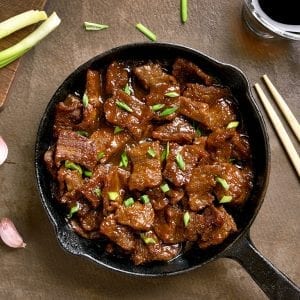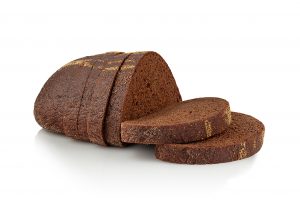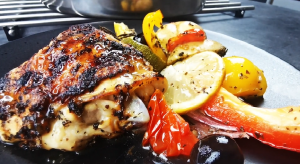Get ready to create a delightful fusion of flavors in your kitchen with this Mongolian Beef Delight recipe. This dish is inspired by traditional Mongolian cuisine and offers the perfect blend of succulent beef, aromatic ginger, and garlic, all simmered in a rich soy sauce and brown sugar glaze.
The main ingredient in this dish is the flank steak, which can be found in the meat section of most supermarkets. However, you may need to ask your butcher for it if you don't see it on display. Fresh ginger and lite soy sauce are other key ingredients here. Fresh ginger can usually be found in the vegetable section, while lite soy sauce is often located in the international foods aisle. Lastly, don't forget to pick up some dark brown sugar, which is usually located in the baking aisle.
Ingredients for Mongolian Beef Delight
Flank steak: This is a lean cut of beef from the abdominal muscles or lower chest of the cow. It's flavorful and tender when thinly sliced against the grain.
Cornstarch: This is used to coat the beef before frying, giving it a crispy texture.
Canola oil: It is used for frying the steak. It has a neutral taste and high smoke point, making it perfect for stir-frying.
Fresh ginger: This adds a zesty, peppery flavor to the dish.
Garlic: Used for its strong, pungent flavor.
Lite soy sauce: This gives the dish its salty, umami flavor.
Water: Used to dilute the sauce to the right consistency.
Dark brown sugar: It adds sweetness and a deep, rich color to the sauce.
Scallion stalks: These are used for garnishing and add a bright, fresh flavor to the dish.
One reader, Aida Bishop says:





I recently tried the Mongolian Beef Delight recipe and it was a hit! The flavors were amazing and the dish was so easy to make. The combination of tender beef and savory sauce was simply delightful. I highly recommend trying this recipe for a delicious and satisfying meal.
Mastering the Techniques for Mongolian Beef Delight
How to slice the flank steak: Slice the flank steak against the grain to ensure tenderness and then coat it with cornstarch in a ziploc bag.
How to sauté ginger and garlic: Sauté the ginger and garlic in the pan for 10 to 15 seconds to release their flavors without burning them.
How to thicken the sauce: Let the sauce come to a boil and then allow it to thicken for 20 to 30 seconds after adding the steak back in.
How to serve: Serve the Mongolian beef immediately for the best flavor and texture.
How To Make Mongolian Beef
Now you can have the sweet, salty, and highly umami taste of a traditional Mongolian beef in this easy recipe. Whip up a serving in just under 30 minutes!
Serves:
Ingredients
- 1lbflank steak
- ¼cupcornstarch
- ¼cupcanola oil
- 2tspfresh ginger,minced
- 1tbspgarlic,minced
- ⅓cuplite soy sauce,low sodium
- ⅓cupwater
- ½cupdark brown sugar
- 4scallion stalks
Instructions
-
Slice the flank steak against the grain and add it to a Ziploc bag with the cornstarch. Press the steak around in the bag, making sure each piece is fully coated with cornstarch and leave it to sit.
-
Add the canola oil to a large frying pan and heat on medium high heat.
-
Add the steak, shaking off any excess corn starch, to the pan in a single layer and cook on each side for 1 minute. When the steak is done cooking, remove it from the pan.
-
Add the ginger and garlic to the pan and sauté for 10 to 15 seconds. Add the soy sauce, water and dark brown sugar to the pan and let it come to a boil.
-
Add the steak back in and let the sauce thicken for 20 to 30 seconds. Add the green onions, stir to combine everything, and cook for a final 20 to 30 seconds.
-
Serve immediately, and enjoy!
Nutrition
- Calories: 427.79kcal
- Fat: 23.14g
- Saturated Fat: 4.92g
- Trans Fat: 0.05g
- Monounsaturated Fat: 12.47g
- Polyunsaturated Fat: 4.26g
- Carbohydrates: 28.25g
- Fiber: 0.68g
- Sugar: 18.08g
- Protein: 26.46g
- Cholesterol: 77.11mg
- Sodium: 835.29mg
- Calcium: 67.59mg
- Potassium: 527.43mg
- Iron: 2.47mg
- Vitamin A: 7.50µg
- Vitamin C: 3.53mg
Elevate Your Mongolian Beef Delight with This Technique Tip
When coating the flank steak with cornstarch, ensure that each piece is evenly coated. This will help to create a crispy exterior when fried. Also, when cooking the steak, avoid overcrowding the pan. This allows the steak to cook evenly and achieve a nice sear. If necessary, cook the steak in batches to avoid overcrowding.
Time-Saving Tips for Making Mongolian Beef Delight
Prep ahead: Chop vegetables and measure out ingredients in advance to streamline the cooking process.
One-pan wonders: Opt for recipes that require minimal cleanup, such as stir-fries or sheet pan meals.
Efficient organization: Arrange your workspace so that all necessary tools and ingredients are within easy reach.
Quick cooking methods: Utilize techniques like stir-frying or pressure cooking for faster meal preparation.
Multi-tasking: When possible, work on multiple components of the recipe simultaneously to expedite the cooking process.
Substitute Ingredients For Mongolian Beef Recipe
flank steak - Substitute with sirloin steak: Sirloin steak is a lean and flavorful cut that can be used as a substitute for flank steak in this recipe. It has a similar texture and can be sliced thinly for stir-frying.
cornstarch - Substitute with tapioca starch: Tapioca starch can be used as a gluten-free alternative to cornstarch. It has similar thickening properties and will help create a crispy coating on the beef.
canola oil - Substitute with vegetable oil: Vegetable oil can be used as a substitute for canola oil in this recipe. It has a neutral flavor and high smoke point, making it suitable for high-heat cooking.
fresh ginger - Substitute with ground ginger: Ground ginger can be used as a substitute for fresh ginger in this recipe. Use it in smaller quantities, as it is more concentrated in flavor than fresh ginger.
garlic - Substitute with garlic powder: Garlic powder can be used as a substitute for fresh garlic in this recipe. It will provide a similar flavor without the need for mincing or chopping.
lite soy sauce - Substitute with tamari: Tamari is a gluten-free alternative to soy sauce and can be used as a substitute in this recipe. It has a rich umami flavor and is slightly thicker than regular soy sauce.
dark brown sugar - Substitute with coconut sugar: Coconut sugar can be used as a substitute for dark brown sugar in this recipe. It has a similar caramel-like flavor and will add sweetness to the dish.
scallion stalks - Substitute with chives: Chives can be used as a substitute for scallions in this recipe. They have a mild onion flavor and can be used as a garnish or added during cooking.
Presenting Mongolian Beef Delight in Style
Elevate the plating: When presenting the Mongolian beef delight, focus on creating an elegant and visually appealing presentation. Use clean lines and minimalistic plating to showcase the dish's vibrant colors and textures.
Incorporate contrasting colors and textures: Utilize vibrant green scallions to add a pop of color against the rich, caramelized beef. Consider incorporating a garnish of sesame seeds for added texture and visual interest.
Focus on balance and symmetry: Arrange the components of the dish thoughtfully, ensuring a harmonious balance of flavors and textures in each bite. Pay attention to the placement of each element to create a visually balanced composition.
Emphasize the umami factor: Highlight the savory umami flavors of the dish by presenting it in a manner that accentuates its depth of flavor. Consider using a sleek, dark-colored plate to enhance the visual impact of the dish.
Incorporate artistic drizzling: Use the sauce as a canvas to create artistic drizzles on the plate, adding a touch of finesse to the presentation. Pay attention to the flow and movement of the sauce to create an eye-catching design.
Utilize negative space: Embrace the concept of negative space to allow the dish to breathe visually. Avoid overcrowding the plate and instead, focus on creating a visually striking presentation with well-considered empty spaces.
Consider the vessel: Choose a sophisticated and contemporary vessel for serving the Mongolian beef delight. Opt for a sleek, modern plate or bowl that complements the dish and elevates its overall presentation.
Highlight the freshness of the ingredients: Showcase the freshness of the scallions by incorporating them as a prominent visual element in the plating. Consider using them as a garnish to add a touch of brightness to the dish.
Essential Tools for Crafting Mongolian Beef Delight
Cutting board: A flat, sturdy surface used for cutting and preparing ingredients.
Chef's knife: A versatile, all-purpose knife used for chopping, slicing, and dicing various ingredients.
Frying pan: A shallow pan with a long handle, used for frying, searing, and sautéing ingredients.
Ziploc bag: A resealable plastic bag used for marinating and storing food.
Measuring cups: Used for accurately measuring dry and liquid ingredients.
Measuring spoons: Small spoons used for measuring small amounts of ingredients.
Whisk: A kitchen tool used for blending and mixing ingredients together.
Spatula: A flat, flexible utensil used for flipping and turning food while cooking.
Frying spatula: A spatula with a wide, flat surface, used for flipping and turning larger pieces of food in a frying pan.
Large frying pan: A wide, shallow pan used for frying, sautéing, and cooking larger quantities of food.
Cooking tongs: A utensil with two arms and a pivot used for gripping and lifting hot items.
Serving plate: A flat dish used for serving and presenting the finished dish.
Storing and Freezing Mongolian Beef Delight for Later
- Allow the Mongolian beef to cool completely before storing or freezing.
- To store in the refrigerator, place the cooled beef in an airtight container. It will keep well for up to 3-4 days.
- For longer storage, you can freeze the Mongolian beef:
- Transfer the cooled beef and sauce to a freezer-safe container or resealable bag.
- Remove as much air as possible from the bag to prevent freezer burn.
- Label the container or bag with the date and contents.
- Place in the freezer, where it will keep for up to 2-3 months.
- To reheat, thaw the frozen Mongolian beef overnight in the refrigerator.
- Transfer the thawed beef and sauce to a pan and heat over medium heat, stirring occasionally, until warmed through.
- If the sauce appears too thick after thawing, you can thin it out with a little water or beef broth while reheating.
- Serve the reheated Mongolian beef over freshly cooked rice or noodles for best results.
How To Reheat Mongolian Beef Delight Leftovers
Stovetop method: heat a large skillet or wok over medium-high heat and add a small amount of canola oil or vegetable oil. Once hot, add the leftover mongolian beef and stir-fry for 2-3 minutes until heated through. If the sauce has thickened too much, add a splash of water or beef broth to thin it out.
Microwave method: place the leftover mongolian beef in a microwave-safe dish and cover with a damp paper towel. Microwave on high for 1-2 minutes, stirring halfway through, until heated through. Be careful not to overheat, as this can cause the beef to become tough and rubbery.
Oven method: preheat your oven to 350°F (175°C). Place the leftover mongolian beef in an oven-safe dish and cover with foil. Bake for 10-15 minutes, or until heated through. Remove the foil for the last few minutes of reheating to allow the sauce to thicken and the edges to crisp up slightly.
Slow cooker method: if you have a larger portion of leftover mongolian beef, you can reheat it in a slow cooker. Place the leftovers in the slow cooker and add a small amount of water or beef broth to prevent the sauce from drying out. Cook on low for 1-2 hours, or until heated through.
Regardless of the reheating method you choose, be sure to stir the mongolian beef occasionally to ensure even heating and prevent scorching. You may also want to taste and adjust the seasoning before serving, as flavors can sometimes become muted during storage.
Fascinating Facts About Mongolian Beef Delight
The Mongolian Beef Delight recipe is a popular dish in Chinese cuisine. It is believed to have originated in Taiwan and is known for its sweet and savory flavors. The dish typically features thinly sliced flank steak, which is stir-fried with a flavorful sauce made from soy sauce, brown sugar, and aromatics like ginger and garlic. The use of cornstarch in the recipe helps to create a crispy coating on the beef, adding a delightful texture to the dish. This dish is often served with steamed rice or noodles and is a favorite in many Chinese restaurants.
Is Making Mongolian Beef Delight at Home Cost-Effective?
The cost-effectiveness of this Mongolian beef delight recipe is quite high. The ingredients, such as flank steak, cornstarch, and soy sauce, are relatively affordable and can be found in most households. The dish is flavorful and satisfying, making it a great option for a family meal. On a scale of 1-10, I would rate this recipe an 8 for its balance of cost and taste. The approximate cost for a household of 4 people would be around $15-$20, making it a budget-friendly choice for a delicious and hearty meal.
Is Mongolian Beef Delight Healthy or Unhealthy?
The Mongolian beef delight recipe, while delicious, has some aspects that could be considered unhealthy:
- The recipe uses a significant amount of oil for frying the beef, which can add extra calories and unhealthy fats to the dish.
- The sauce contains a considerable amount of brown sugar, which is high in calories and can contribute to blood sugar spikes.
- Soy sauce is high in sodium, and using ⅓ cup in the recipe may result in an excessive amount of salt per serving.
However, the recipe also includes some healthy ingredients:
- Flank steak is a lean cut of beef, which is a good source of protein and relatively low in fat.
- Ginger and garlic offer various health benefits, such as anti-inflammatory properties and potential immune system support.
- Scallions provide a small amount of vitamins and minerals.
To make this recipe healthier, consider the following suggestions:
- Reduce the amount of oil used for frying the beef, or opt for a healthier cooking method like stir-frying or grilling.
- Decrease the amount of brown sugar in the sauce, or replace it with a natural sweetener like honey or maple syrup.
- Use low-sodium soy sauce to reduce the overall salt content of the dish.
- Increase the amount of vegetables in the recipe by adding sliced bell peppers, broccoli, or carrots to boost the fiber and nutrient content.
- Serve the Mongolian beef with a side of brown rice or quinoa instead of white rice to incorporate more whole grains and fiber into the meal.
- Control portion sizes to maintain a balanced intake of calories and nutrients.
By making these adjustments, you can enjoy the flavors of Mongolian beef while promoting a healthier lifestyle.
Editor's Take on the Delightful Mongolian Beef
The Mongolian Beef Delight recipe is a delightful combination of tender flank steak, savory soy sauce, and aromatic ginger and garlic. The use of cornstarch gives the beef a crispy texture, while the dark brown sugar adds a rich sweetness to the dish. The balance of flavors and textures in this recipe is truly impressive. The quick cooking time ensures that the beef remains tender and juicy. Overall, this dish is a perfect blend of sweet and savory, making it a delightful addition to any meal.
Enhance Your Mongolian Beef Recipe with These Unique Side Dishes:
Delicious Alternatives to Mongolian Beef Delight
Appetizers and Desserts to Complement Mongolian Beef Delight
Why trust this Mongolian Beef Recipe:
This recipe for Mongolian Beef Delight is a guaranteed flavorful and authentic dish that will surely impress your taste buds. The combination of tender flank steak coated in a crispy cornstarch crust, and the rich, savory sauce made with fresh ginger, garlic, and lite soy sauce creates a harmonious balance of flavors. The addition of dark brown sugar adds a touch of sweetness, while the scallions provide a refreshing and aromatic finish. Trust this recipe to deliver a delicious and satisfying Mongolian beef experience that will leave you craving for more.
Was this page helpful?
Have your own special recipe to share? Submit Your Recipe Today!














